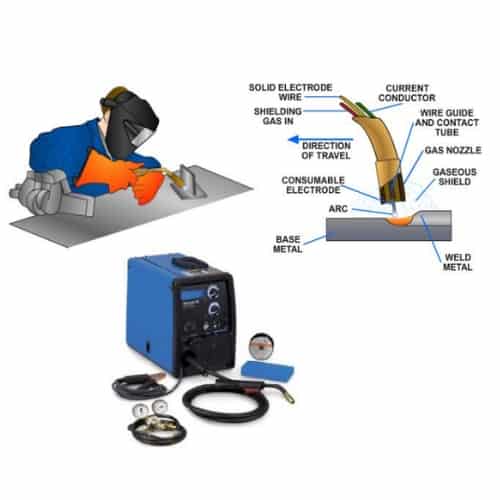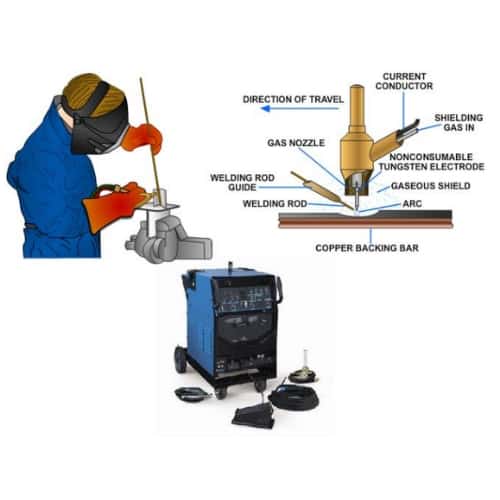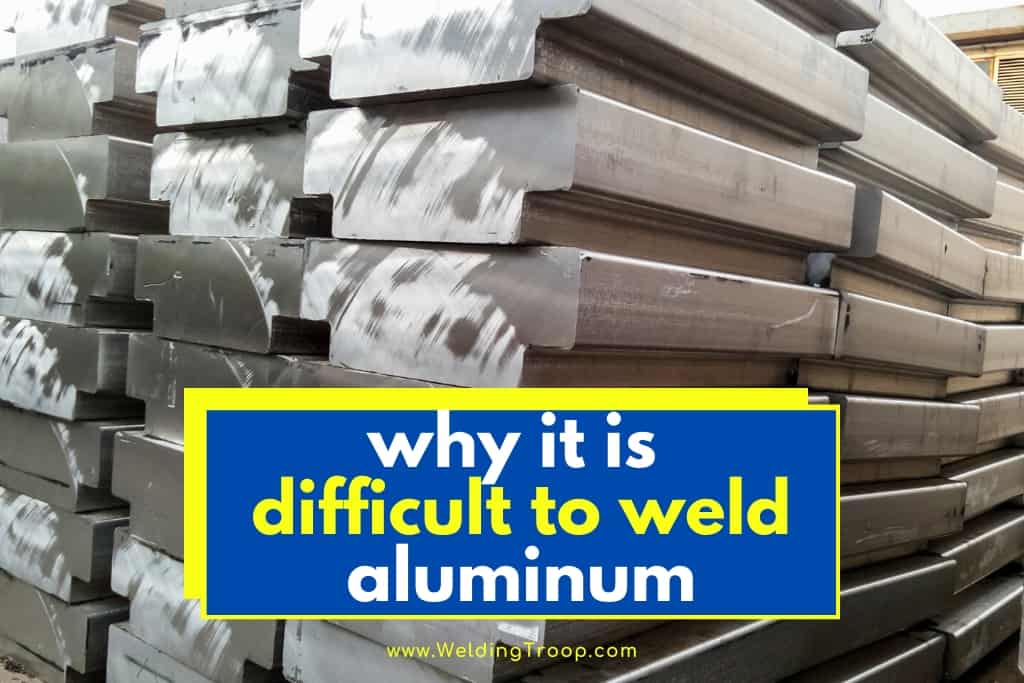Welding is a significant career in the United States and an excellent way to make money. Some people even pick it up as a hobby. A welding certification can take anywhere from 6-8 months to obtain, and after that, the job opportunities are endless. Welders make an average of $44,360 a year and in many places that can let anyone lead a suitable lifestyle.
Why is it difficult to weld with aluminum? The characteristics and what aluminum is made to make it hard for welders to work with. There are a few other reasons that aluminum is more complicated and why most welders prefer different materials.
An experienced welder will know what to do with aluminum and what it takes to weld. There are also a few materials welders prefer over others. The world of welding is a fascinating one and is a great skill to learn.
Table of Contents
What Is The Hardest Metal To Weld?
Aluminum is considered to be the hardest metal to weld due to its poor heat conductivity, poor fusion region, inadequate penetration, and difficulty in holding a joint together.
It requires special tools and techniques, such as using a smaller welder, higher current settings, and a wire feed speed setting with lower values.
TIG equipment is also suggested, along with the use of aluminum filler wire when working with high-purity or aerospace grades of aluminum. Other challenging metals to weld include cast iron, brass, bronze, copper, and titanium, all of which require specific tools and understanding to achieve a successful weld.
Are Aluminum Welds As Strong As Steel?
Aluminum welds can be strong, but they are generally not as strong as steel welds. Aluminum has a lower melting point than steel and is more susceptible to cracking during the welding process.
Moreover, welding aluminum weakens the material due to the loss of yield strength and changes in its temper. However, with proper welding techniques and filler metal selection, aluminum welds can still be strong enough for many applications.
It’s essential to evaluate the specific project requirements when determining the appropriate welding material and technique.
Why Does Aluminum Crack After Welding?
Aluminum can crack after welding due to a high-temperature cracking mechanism known as hot cracking. This occurs when the metal solidifies and shrinks during the welding process, causing it to crack. Hot cracking is mostly a function of how metal alloy systems solidify and is primarily dependent on the chemistry of the aluminum base alloy.
Weld cracks are the most common defects when welding aluminum. They occur due to alloying with elements such as copper, silicon, and magnesium that have higher melting points than aluminum.
The sensitivity to cracking is dependent on the percentage of these alloying elements. Adjusting the alloy composition with filler wire and using proper joint design with a generous bevel that allows for adding more filler can mitigate hot cracking.
What Happens If You Try To Weld Aluminum To steel?
Welding aluminum directly to steel is not recommended because aluminum has a much lower melting point than steel and the two metals have vastly different properties.
Aluminum and steel have different thermal conductivities, with aluminum being a better conductor. Additionally, welding aluminum to steel can lead to galvanic corrosion due to the dissimilar metals being in contact with each other.
In such cases, it is better to use mechanical fasteners or adhesive bonding to join aluminum and steel components.
Can Any Welder Weld Aluminum?
No, not all welders can weld aluminum. Welding aluminum requires different techniques and procedures than welding steel due to its unique characteristics, such as its lower melting point, oxide layer, and increased thermal conductivity. Welding aluminum should only be performed by professionals who are trained and have experience in aluminum welding.
The top 6 reasons why welding aluminum is hard
Some materials are harder dealing with, and that goes for any trade you learn. Knitters have preferred yarn; makeup artists have preferred foundation, and welders have preferred materials too. There are a few reasons it is hard to weld.
1. Form – The form of this material is an ore or alloy, making it a hassle to weld.
2. Melting – The melting point of aluminum is much lower than other metals. It tends to burn before it melts properly.
3. Oxidized – Aluminum tends to oxidize quicker than other metals. It is not a metal that can rust, but it does have corrosion, which is what they mean by oxidation.
4. Softer – Believe it or not, this is softer than other materials and can be distorted or abused easily.
5. Thermal expansion – Aluminum expands much more than other metals. This can lead to some severe welding problems. However, there are now specialized tools that can help with the expansion.
6. Insulator – It is an electrical insulator making it hard to maintain an arc.
There are many reasons welders prefer to use a different material. However, the fantastic thing is welding has grown and expanded in many ways.
Many of the newer tools on the market can help weld aluminum in ways we weren’t able to before.

The characteristics and advantages of aluminum
With each material comes different characteristics and aluminum even if it may seem ordinary has some unique things that set it apart from other metals. There are actually many advantages to aluminum!
• It is excellent for heat-conducting! This may make it hard to weld, but it is one of the properties aluminum is known for. This feature makes it one of the top choices for power transmission lines!
• Aluminum makes a superb reflector. It helps create a lot of the reflectors we use as well as rescue blankets.
• An exciting fact about steel is that it becomes brittle at lower temperatures. However, the opposite can be said for aluminum. This material strengthens at lower temperatures.
• It is not a toxic substance like other materials welder’s use.
• Aluminum is recyclable! Unlike some other metals and materials, this can be recycled and reused.
There are many excellent properties of aluminum that can make it a fantastic material to use in our everyday lives. That doesn’t necessarily mean it is easy for our beloved welders to use. It is a particular skill to learn as a welder.
Read also >> How to Weld Aluminum at Home >> A Beginner’s Guide
Read also >> Can You Weld Aluminum Without Gas? Is It Possible?
Read also >> 8 Reasons Your Aluminum Welds Are Black – How to Avoid Them
Read also >> Can Plasma Cutter Cut Aluminum? (Here Is How)
Tools for welding aluminum
Most people have heard of MIG welding, which has to do with the types of tools they use and how they weld certain metals. The best equipment for welding aluminum is called a TIG, also known as tungsten inert gas.
This process does not require wire feeding that other metals do require. Wire feeding is when a welder uses a long feed of material or wire to create weld joints. No mechanical feeding is needed; this can be another significant issue in welding.
Related reading: How to Weld Aluminum at Home >> A Beginner’s Guide
The most accessible metals to weld
With any career or hobby that involves building or creating, there are some preferred materials. So, what are those preferred materials? Stainless steel, low carbon mild steel, and many other iron-based metals. There are many characteristics of these metals that make it suitable for welding. For example:
These materials have excellent cooling rates that make them easy to work with, and they are quicker to weld. Other materials have a high amount of shielding gasses, and these materials have less, meaning welders use less inert gas to weld products.
What makes a good welding material?
Every material is different and has different melting points. Each welder will have their own preferred materials, but here are some of the most commonly used materials when welding.
• Steel or stainless steel. This can be good for many different kinds of welding techniques, making it widely adopted. It has some of the lowest amounts of elements, making it easier to work with. There is less risk of having a lousy weld with this material.
• Cast Iron. This is some of the best for manual welding. This form of welding has been around for centuries, and cast iron has been one of the best for this type of welding.
How to Weld Cast Iron NO Pre-Heating >> Check out the video below
• Magnesium. This can easily be an excellent material for welders to work with. Though it has similar properties to aluminum, it can be easy to work with if you have practice. To do this weld properly, you will have to remove any oxides before the process begins.
• Titanium. Another great material for welders. This is another material you will have to protect from oxidization.
Many welders prefer different kinds of materials. Depending on the welding degree or certificate, someone gets will also help determine what kind of stuff they are comfortable working with.
Types of welding
Many of you may not know that there are actually several types of welding. Each style can weld different things, and some variety have better luck with specific materials.
• MIG – This is one of the most common types of welding that uses various irons and other materials. This uses a gas shield to create products while welding.

• TIG – A different kind of standard welding that is great for dealing with aluminum and anything like it. For example, this type of welding would be great for magnesium as well.

• Flux -cored welding- This type of welding was creating in the 1950s. It is used for projects that need to be done quickly; this makes it suitable for anyone in construction, which requires a product on the spot.
• Plasma Arc Welding – This type of welding is a lot like Gas Tungsten Arc Welding; the difference is the type of torch the welder will use during the process. This torch can melt metals at a super high temperature.
• Energy Beam Welding – Probably one of the coolest types of welding out there. This style uses laser beams to melt pieces of metal.
Many more types of welding exist, but it also depends on what some know how to do and what machines they were trained to use. Each has their own qualifications, tools, and training programs to be able to weld correctly.
Final thoughts
Aluminum is not one of the easiest metals to weld, but it is useful in our everyday lives. It can have some challenged, but many welders who are experienced will understand how to work around them.
The key is to get proper training, understand the elements behind each metal, and understand the chemistry. Also, it is crucial to have the right tools. Different pieces of equipment will be able to do different things and work with other materials.
Related reading: How Long Does it Take to Learn Welding?
How to “Weld” Aluminum for Beginners >> Check out the video below

